Bosnia and Herzegovina art
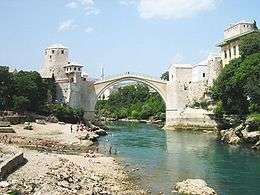
| Part of a series on the |
| Culture of Bosnia and Herzegovina |
|---|
 |
| History |
| People |
| Languages |
|
Mythology and folklore |
| Cuisine |
| Festivals |
| Religion |
| Art |
| Literature |
|
Music and performing arts |
| Sport |
|
Monuments |
|
Bosnia and Herzegovina art is the genesis and heritage, from the region of Bosnia and Herzegovina, and its constituent ethno-religious groups (Bosniaks, Serbs and Croats) from prehistoric times to today.
Ancient Heritage
Prehistory

In the boundaries of today’s Bosnia and Herzegovina there have been many layers of prehistory cultures and their creation and disappearance is linked to migrations of unidentified ethnic groups.
Paleolithic in Bosnia and Herzegovina is marked with the oldest monument of Paleolithic in southeastern Europe - engravings in a cave named Badanj near Stolac in Herzegovina. Most famous being the Horse attacked by arrows, preserved in fragments and dated around 14500-12000 B.C.[1]
During the time when Neolithic and Copper cultures were starting to appear, in Bosnia and Herzegovina began interesting mixture of Mediterranean cultures and those of Panonian cultures. Herzegovina was under the influence of impresso ceramics from western Mediterranean as seen in Green Cave near Mostar, Čairi near Stolac, Lisičići near Konjic and Peć Mlini near Grude. People used to live in caves or simple settlements on hilltops. In the upper mainstream of Bosna river and northeast parts of Bosnia (Obra I near Kakanj) people used to live in wooden houses built along rivers. In that culture we can see influences from Adriatic cultures on south and Starčević culture on northeast. Original expressions of that culture are ceramic pots on four legs, so called – riton. We can find the also in Danilo culture on the Croatian coast. Thanks to these pieces, Kakanj culture is considered a part of wide circle of Neolithic nations that followed a cult of life force (from northern Italy, Dalmatia and Epirus to Aegean). Butmir Culture near Sarajevo is distinctive with fine glazed ceramics with miscellaneous geometrical decorations (often spirals).[2][3] Figures from Butmir are unique sculptures modeled with hand; heads are almost like portraits with emphasized parts of body.

Bronze Age settlements in Herzegovina were built like citadels (natively called - gradina), and in Bosnia we have necropolises with stone tumuli. During that time, bronze arms, decorated plates, flat necklaces and fibulas were decorated with specific geometrical style of engraved ornaments.
From 7th century BC bronze is replaced by iron, and only jewelry and art objects were still made out of bronze. Bronze culture of Illyrians, ethnic group with distinct culture and art form started to organize itself on today’s Croatia, Serbia, Bosnia and Herzegovina. Different Illyrian tribes, under the influence of Halstat cultures from north, formed original regional centers. With the notable exception of Pod near Bugojno in the upper valley of the Vrbas River, nothing is known of their settlements. In eastern Bosnia in the cemeteries of Belotić and Bela Crkva, the rites of inhumation and cremation are attested, with skeletons in stone cists and cremations in urns. Metal implements appear here side-by-side with stone implements. Most of the remains belong to the fully developed Middle Bronze Age. Very important role in their life was the cult of the dead, which is seen in their careful burials and burial ceremonies, as well as richness of the burial cites. In northern parts there was long tradition of cremation and burial in shallow graves, while in the south the dead were buried in large stone, or earth tumuli (natively called – gromile) that in Herzegovina were reaching monumental sizes, more than 50 m wide and 5 m high. Japodian tribes (found around Bihać) have had affinity to decoration (heavy, oversized necklaces out of yellow, blue or white glass paste, and large bronze fibulas, as well as spiral bracelets, diadems and helmets out of bronze foil.
In 4th century BC first outbreak of Celts is recorded. They brought the technique of the pottery wheel, new types of fibulas and different bronze and iron belts. They only passed on their way to Greece, so their influence in Bosnia and Herzegovina is negligible.
Antiquity


In the Neretva Delta in the south there was important Hellenistic influence of Illyrian tribe Daors. Their capital was Daorson in Ošanići near Stolac;[4] to date, main center of Ancient culture in B&H. Daorson in 4th century BC was surrounded by megalithic, 5 m high stonewalls (large as those of Mycenae in Greece),[5] composed out of large trapeze stones blocks. Daors have made their unique bronze coins and sculptures. Finally, Romans subdued the Illyrians in first century BC, and after that the history of these parts is history of Illyrian provinces of Rome and Byzantium.
In Bosnia and Herzegovina Romans built several small temples decorated with reliefs. The complex of step sanctuary in Gradac near Posušje from year 184 AD had marble temple dedicated to recently deceased emperor Marcus Aurelius. On the reliefs we can feel naturalism of native craftsmen, and in mosaics the Hellenistic influence, especially in those found in villas near Stolac (second half of the 3rd century). Late Roman art in B&H is marked with building of villas, Christian mausoleums, basilicas and oratories like: Mausoleum in Šipovo near Jajce and Villa Mogorjelo[6] near Čapljina (early 4th century). Sculptures that we inherited are ones like: Hellenistic relief of Minerva, Jupiter and genius-protector from Šipovo (2nd century) and extremely barbarically stylized relief of four friends from Zenica (end of the 4th century).[7]
Medieval art in Bosnia and Herzegovina
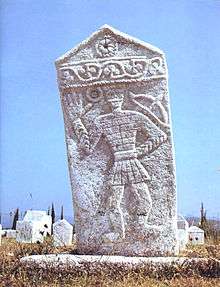
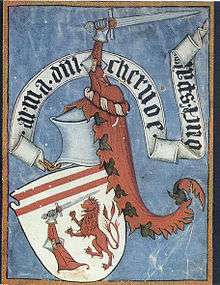
In Bosnia and Herzegovina the Romanesque influence came from Croatia and it was never accepted in full, only in use of some elements. Those few monuments with Romanesque elements that were preserved are dating from later times. For example: in the motifs from tombstones in Bosnia – natively called stećak (14th century), or the high parts of Tower of St. Luke in Jajce (15th century).
Influences of Gothic art in the 14th century are supported by culture of urban cities, preaching orders, and knightly culture. On Bosnian culture there was slight influence of religion and the strong one of Nobility. That is recognizable in the organization of a city that is actually a settlement close to feudal fortress. Feudal fortress is of thick roughly cut stonewalls, shape is following the terrain, buildings have steppe roofs and towers are often and high. The most beautiful one is perhaps Royal Court in Kraljeva Sutjeska; it has gothic portals and windows, buttresses, and high rooftops (very practical because of snow).
The way some Bosnian nobility treated its dead is somewhat special. From the earliest times of Bosnian Kingdom the nobility was buried in large necropolises near the roads with graves marked by a monumental tombstone called stećak. Stećak (or mramor or bilig) comes in several different shapes and was sometimes engraved with reliefs showing all sorts of motifs, from figurative to symbols, and sometimes writings in Bosnian Cyrillic. Their existence is strongly linked with heretical Bosnian Church and most of the motifs are derived from their beliefs, but some derived from Romanesque (crosses, arcades with semi-circular arches, son, half-moon etc.) and Gothic (arcades with sharp arches, knight riders, shields, swords, lilies etc.) art of the West.
There are two beautiful examples of illuminated manuscripts from medieval Bosnia. Hval’s missionary, kept in Zagreb, is ravishingly decorated manuscript with many miniatures. Misal Hrvoja Vukčića Hrvatinića - a liturgical book of the Bosnian duke and ruler of Dalmatia - Hrvoje Vukčić Hrvatinić, today in Istanbul, is colourfully painted with many details of knightly culture (knights, crests etc.). Both were painted in Split, Croatia.
Ottoman Art in Bosnia and Herzegovina

In the 16th century, entire Bosnia was under Ottoman rule so the influences of renaissance and later baroque from west were extinguished. The only places where some western art could be fined were lonesome Franciscan monasteries in Visoko, Kreševo, Franciscan monastery in Fojnica, Franciscan monastery in Kraljeva Sutjeska etc.
However, that opened a new era in B&H art, that of Islamic Art and it flourished until the 19th century. Actually there were three constant art traditions in B&H living side by side: Catholic-Western one, Orthodox-Byzantine (unique illuminated manuscripts and painted icons) and one and Ottoman-Islamic that was the most powerful one.
Ottomans were developing urban cities very fast upon their conquest of B&H. Enriched by Islamic and Byzantine experiences they build so much that it can be compared only with medieval building in Dalmatian cities. For example, in Foča in 16th century Ottomans build 17 mosques, 29 public fountains, 6 public baths (hamam) and 13 caravanserai motels (han). Sarajevo is an example of a non-urban open city where the most important buildings are organized around one veining street – čaršija (Persian chahar-su meaning all four sides). In Sarajevo the largest is famous Baščaršija with shops of 50 different crafts from the 15th century. Also in Baščaršija is most impressive Gazi Husrev-beg’s mosque, also known as Beg’s mosque, built in 1531. Founded on Byzantine central square plan it has dome on large drum, two smaller domes leaning on both sides of drum and a semi-dome behind; in addition, above entrance is a porch with five tiny domes. Inside it is filled with rich wall ornaments in wood and Arabic calligraphic writings. The complex is complete with a high tower (munara) and fountain (šedrvan) in the courtyard.
Islamic manuscripts, decorated in the Persian style with beautiful Islamic calligraphy, were often in B&H so now we have numerous examples in the Bosnian libraries. In the 16th century the Jews expelled from Spain came to Sarajevo where they were allowed to settle. Beside important influence on Bosnian culture, they brought with them luxury decorated manuscript called Sarajevo Haggadah from the 14th century, now in the Sarajevo museum.
The Bridge in Islamic art was very important, not only because it request great skill of an architect, but also because of symbolic meaning of a bridge in Islam where it is a mediator between heaven and earth. That’s why there is no surprise that the high point of Islamic architecture in B&H is a bridge. Bridge of artisan Hajredin (pupil of the famous architect Mimar Sinan from Istanbul) in Mostar (so called: Old Bridge) with its arch over river Neretva is 29 m long and 19,5 m high. With subtle parabola it looks higher and more fragile than it is, an effect seen only in Gothic cathedrals.
In Bosnian Islamic architecture, stone is reserved for religious, public buildings and fortifications, while private houses were built out of wood and ćerpić (native simple bounding material made of clay and straw). With often consol constructions of the upper floors they could be more open with large windows. When the power of Ottomans started to descend in the middle of the 17th century, so did the influence of Islamic art in Bosnia and Herzegovina.
Art in Austro-Hungarian Period
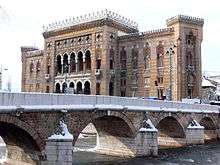
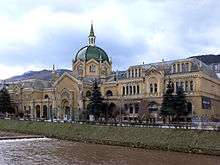
Right after the Austro-Hungarian occupation the art scene in Bosnia comes alive. Intense building is represented in modernisation and structural transformation of cities. Architecture is in eclectic pseudo styles like classicism, neo-renaissance, neo-baroque, and even neo-Romanesque, and neo-gothic. Unique pseudo style is “oriental eclectic” style (also "Pseudo-Moorish style") based on Moorish architecture of southern Spain and Egypt. That style, was quite foreign to urban ambient of Bosnian cities as can be seen in Sarajevo (National Library and City Hall), Mostar Gymnasium and Travnik (Retirement Home).
The first Bosnian artists were educated in large European academies (Vienna, München, Prag, Krakow, Budapest and Paris) thanks to scholarships of cultural societies like “Prosvjeta” and “Napredak”. All those artists like Atanasije Popović, Lazar Drljača, Gabrijel Jurkić, Branko Radulović, Petar Šain etc., are marked with academism with slight touches of impressionism, art nouveau, and pointillism. After the Great Exhibition of Bosnian Artists in 1917, the native born artists have prevailed. Modern styles that entered B&H were expressionism and Cézannes-ism.
Art in the Yugoslavian Kingdom
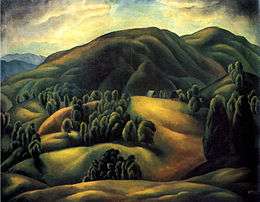
After the end of World War I, the society of artists from SHS (state of Serbians, Croats and Slovenians) was organized and they held numerous exhibitions and artistic gatherings like the Blažuj colony of Vladimir Becić. Participants of that colony were Roman Petrović and Jovan Bijelić that derived their art to abstract form (c. 1920), while Karlo Mijić is devoted to colouristic landscapes. Karlo Mijić, with art nouveau and impressionistic influences was probably the best painter of 20s and 30s in the entire Yugoslavia.
Sadly, the art production in B&H was reduced to crumbs by the Yugoslavian government, so lots of artist never returned to B&H from their studies in Zagreb and Beograd, while many were also leaving the country. First renewal happened with the “Group of Four” and “engaged art” of Roman Petrović and his cycle called “The children of the Street”. Mijić and Đoko Mazalić founded the art association called “Krug” (The Circle) with strong urban aesthetics of nature. Vojo Dimitrijević painted “Spain in ‘37”; a representative artwork of colouristic expression with traces of Picasso and Chagall.
In thirties the architects were influenced by ideas of functionalism, humane architecture and Bauhaus. Those buildings were uniting a function, content and form, without unnecessary plastic decoration, and with simple rhythm of windows and modern constructions (former Social Security Building in Mostar by Drago Ibler, 1935.).
Art in the Socialist Federal Republic of Yugoslavia
Right after World War II, and founding the new country of all south Slavs Communist Yugoslavia, the artist have found new expression through themes of Revolution and War. Ismet Mujezinović draws numerous expressionistic figures in his cycle “The Battle of Sutjeska”, and Branko Šotra made powerful almost abstract engravings. Architecture was also under the direct influence of Socialistic architecture, but never reached the monumentality of the original works.
In the fifties, careful and slow, the transformation of art through economy and decoration toward abstraction happened. The first was sculptor Mirko Ostoja who replaced classical modeling with iron welding. Even the Communist State changed its feeling toward modern art by commissioning large abstract monuments dedicated to famous battles in The War (Sutjeska, Kozara, Makljen etc.). Young architects, gathered around professor Juraj Neidhardt, were trying to achieve connections of modern architecture and B&H tradition and surroundings. Those were buildings like The Mostar Mall - “Razvitak” in 1970 by A. Paljaga or Jajce Mall in 1976 by R. Jadrić, Dž. Karić and N. Kurto.
In the sixties many architects were leaving traditional boundaries and made important buildings in manner of functionalism: The telecommunication building in Addis Abeba by Ivan Štraus and Zdravko Kovacević, or “Skenderija” Hall in Sarajevo by Živorad Janković and Halid Muhasilović[8]
In the seventies, the rewarded architectural plans were Zenica Theatre in 1977 by Jahiel Finci and Zlatko Ugljen, Hotel Rose in Mostar (1979, by Zlatko Ugljen) and Gripe Hall in Split (1980, by Živorad Janković and S. Rozić).
An art expression inspired by old Bosnian culture and tradition appeared in the graphic work of Dževad Hozo and in paintings of Mehmed Zaimović, Seid Hasanefendić and Mersad Berber. Quite opposite to that, the urban expression of Ismar Mujezinović is more related to modern film montage and photo-optics, while Braco Dimitrijević is a Conceptual artist who works mainly outside B&H.
An example of architecture in the eighties is Holiday Inn Hotel built in 1983 and the “Unis” Twin Towers built in Sarajevo in 1986 and designed by Ivan Štraus. Among the people of the city, the twin towers are commonly called Momo (Serbian name) and Uzeir (Bosniak name).
Art after the Bosnian War
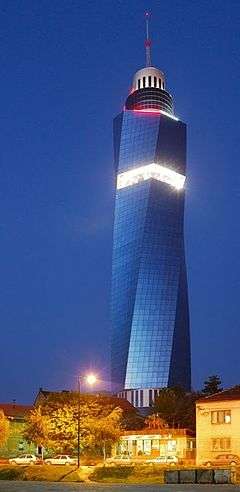
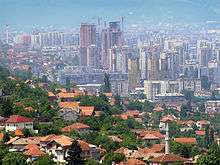
Cultural preservation is under way in Bosnia and Herzegovina which can be seen with the most recent reconstruction of Stari most in Mostar and many other structures of cultural and historical significance which were damaged or destroyed in the recent war. Many other projects, unfortunately, are still stifled by political disputes and lack of funds.
Commercial construction in the years following the Bosnian War has seen a boom in Sarajevo. Sarajevo is one of the cities with the most construction in southeastern Europe. The Unis Twin Towers have been renovated completely. On the site of the former Oslobodjenje Towers, the Avaz towers have now been constructed. In the Hrasno residential area, the Bosnian Company Bosmal has constructed the Bosmal City Center, which includes the tallest set of twin towers in the Balkans at 120 meters each.
The Avaz Twist Tower located in Marijin Dvor, Sarajevo is the tallest tower in Bosnia and Herzegovina. It is the new headquarters for Avaz, the most popular Bosnia and Herzegovina newspaper company.
References
- ↑ Ivan Lovrenović 2001. Bosnia: a cultural history. New York. New York University Press. p. 13
- ↑ W. Radymský / M. Hoernes, Die neolithische Station von Butmir bei Sarajevo in Bosnien. Ausgrabungen im Jahre 1893 (Wien 1895).
- ↑ Z. Kujundzič-Vejzagič / J. Müller / K. Rassmann / T. Schüler, Okolište – Grabung und Geomagnetik eines zentralbosnischen Tells aus der ersten Hälfte des 5. vorchristlichen Jahrtausends. In: B. Hänsel (Hrsg.), Parerga Praehistorica: Jubiläumsschrift zur Prähistorischen Archäologie. 15 Jahre UPA. Universitätsforsch. Prähist. Arch. 100 (Bonn 2004) 69–81.
- ↑ Images of antiquities from Daorson Archived December 7, 2008, at the Wayback Machine.
- ↑ Daorson City Archived October 4, 2009, at the Wayback Machine.
- ↑ Answers.com
- ↑ Ancient monuments - National archeological museum in Sarajevo Archived May 6, 2009, at the Wayback Machine.
- ↑ http://stuff.mit.edu/afs/athena/course/4/4.175/OldFiles/www/center_home_sarajevo_contemporary.htm
- Malcolm, Noel (1994). BOSNIA A Short History. New York University Press. ISBN 0-8147-5520-8.
- Riedlmayer, Andras (1993). A Brief History of Bosnia-Herzegovina. The Bosnian Manuscript Ingathering Project.
- “Umjetničko Blago Bosne i Hercegovine”, several authors, Svjetlost, Sarajevo, 1987.
See also
External links
- Bosnian National Monument - Muslibegovica House
- Gabrijel Jurkic
- Sarajevo Culture Bureau- a website on contemporary art in Bosnia & Herzegovina
